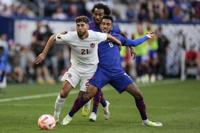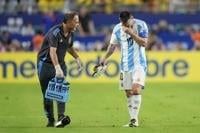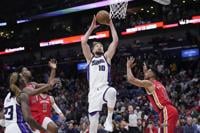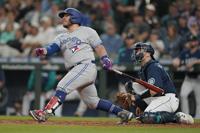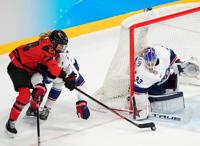TORONTO - For veteran CFL lineman Derek Dennis, Damar Hamlin's horrific injury is another sober reminder of the potential perils of professional football.
Hamlin, a defensive back with the Buffalo Bills, remains in critical condition in a Cincinnati hospital after suffering cardiac arrest on the field in the first quarter of Monday night's game versus the Bengals.
"As a football player, every time we touch the field, we do understand the risks," said Dennis, a six-foot-two, 337-pound tackle who spent last season with the Calgary Stampeders. "We're so conditioned on having this warrior's mindset in the sense of everything we do that sometimes you forget you're playing a violent game, a game that's meant to be played with a certain amount of passion, a certain amount of violence.
"All of the terms coaches teach you even at a young age, they call you a warrior, a savage, a beast, words that are related to be violent that you get so conditioned to it that you forget you are doing something that could put your life at risk. I've seen different scenarios that make the game super tough but (Monday night), I guess because the NFL has that stigma of being the ultimate gladiators and warriors, when you see something like that to the "best of the best, the cream of the crop," it's just scary, man."
Hamlin got up to his feet immediately after tackling Cincinnati receiver Tee Higgins before collapsing on the field. Players from both teams surrounded Hamlin while he was being administered CPR on the field, reportedly for nine minutes.
It was reported that Hamlin needed an automated external defibrillator (AED). Roughly 19 minutes after he collapsed, Hamlin was taken by ambulance to University of Cincinnati Medical Center.
The game, which Cincinnati led 7-3 at the time, was indefinitely postponed. No makeup date has been determined but the NFL announced Tuesday the contest wouldn't be resumed this week.
Dennis, 34, is familiar with element of injury that exists in football. He appeared in 14 regular-season games with Calgary before suffering a season-ending cracked fibula that required surgery.
"My brother-in-law (eight-year veteran offensive guard Jamil Douglas) played in Buffalo and shared a locker next to Hamlin and so they were buddies," Dennis said. "The raw human emotion to it, I think it just put the game into perspective.
"I think people forget sometimes these guys out here (pro football players) are risking life, limb, motor skills for their enjoyment."
It's not the first time something like of this magnitude has happened in professional sports, including football.
On Oct. 24, 1971, Chuck Hughes, a 28-year-old receiver with the Detroit Lions, collapsed on the field from heart failure in the fourth quarter against the Chicago Bears at Tigers Stadium. He was taken to hospital where he was pronounced dead.
During the '75 CFL season, Tom Pate, a rookie American linebacker with the Hamilton Tiger-Cats, died three days after being critically injured in a game versus Calgary. Pate, 23, never regained consciousness.
The CFL Players' Association annually presents the Tom Pate Memorial Trophy to a player who displays outstanding sportsmanship while also making significant contributions to his team, community and the union.
Danish soccer player Christian Eriksen suffered cardiac arrest on the field during a Euro 2020 match against Finland. Eriksen's heart had stopped beating and team doctor Morten Boesen said the player was "gone."
Eriksen not only survived but resumed playing.
Earlier that year, defenceman Jay Bouwmeester of the St. Louis Blues collapsed from cardiac arrest during an NHL game. Bouwmeester had to be revived by a defibrillator before being taken to hospital, where he had an internal defibrillator implanted three days later to regulate his heartbeat.
Bouwmeester announced his NHL retirement 11 months later.
On June 26, 2003 Cameroon midfielder Marc-Vivien Foe collapsed while jogging during a Confederations Cup soccer semifinal versus Colombia. Medical personnel spent 45 minutes trying to restart his heart, but the player was pronounced dead at Lyon's Stade de Gerland.
Following Foe's death, FIFA adopted new training for sideline medical teams in both CPR and the use of defibrillators. The adopted protocols were later applied to assist Eriksen.
During the '98 NHL playoffs, St. Louis defenceman Chris Pronger collapsed on the ice after taking a slapshot from Detroit's Dmitri Mironov to his chest. Fortunately for Pronger, he was able to return to the ice to resume his Hall of Fame career.
"Prayers that Damar Hamlin can have the same outcome that I was fortunate to have with my incident," Pronger tweeted Tuesday. "Our thoughts and prayers go out to Damar, his family, teammates and the greater NFL community during this incredibly scary time."
A fact not lost upon Blues head coach Craig Berube.
"It carries over to all sports and life," Berube told reporters Tuesday before the Blues game versus the Toronto Maple Leafs. "I was part of the one with Bouwmeester here and it puts everything into perspective.
"The most important thing is people's health and life and death and it was terrible to see. I was watching it and it's an ugly situation."
According to the NFL, there are on average 30 health care providers at a stadium on game day. As well, the league uses unaffiliated medical personnel to help identify and review of injuries, including concussions.
CFL teams are required to have AED machines at their facilities for their use at all practices and games and have dedicated emergency on-field personnel who're proficient in their use. During games, the home team must ensure that ambulance, paramedic and other emergency medical services are available in the stadium throughout the contest.
Also, a paramedic ambulance unit with advance life support is also required.
And while the NFL has medical tents on its sidelines, the CFL has a spotter at its command centre who has access to a camera that allows him to see all 24 players on the field. The spotter has the authority to pull a player from a game for safety concerns.
---
John Chidley-Hill contributed to this report from Toronto.
This report by 春色直播was first published Jan. 3, 2023.








